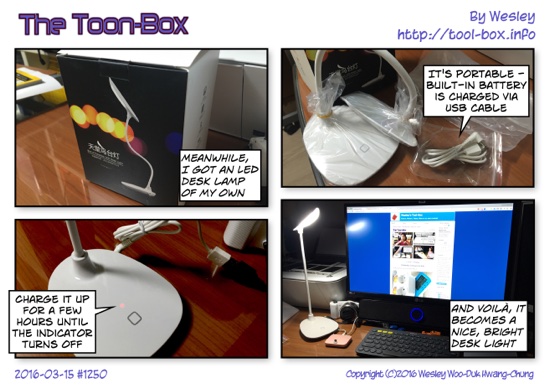Entries tagged as LED
camera astronomy Moon Sanyo VPC-C4 satellite Minolta Dimage X20 binoculars Chuseok telescope eclipse Kodak Z1085 IS star Sun iPhone 4 A1533 iPhone 5S slow motion A1530 LTE iOS iPhone 4S sound Celine Chung electric fan light trail M&M's A1524 iPhone 6 Plus OIS Cortex Camera Focus Pixels A1522 A1549 A1586 barometer belt case iOS 8 iPad iPad mini iPhone 3GS iPhone 5 iPhone 5C iPhone 6 KT LGU+ Christmas tree decoration balls lights sled snow Hayun Chung screwdriver table cookie milk Oreo Homeplus pizza chocolate chip cookies couch FaceTime New Year's Day rice cake Skype Sung-Eun Kim tteokguk computer swing Toys R Us trampoline Mega Kids Box Megabox movie theatre Wesley Woo-Duk Hwang-Chung tortilla wrap toothbrush salad Disney Frozen battery remote controlled helicopter repair replacement Syma S107G Danish butter cookies animation car Larva shopping cart cooler Mac mini USB tailor Ulsan desk wire emart shopping charger assembly kit AT&T SK Telecom fingerprint sensor Touch ID M7 pedometer 3DMark Geekbench Kraken Octane performance SunSpider accelerometer compass gyroscope ISS Han-gang river Seoul passcode Canon SX50 HS flare Iridium Alhena constellation Jupiter Orion subway travel artificial star Celestron NexStar 6SE collimation iPhone 6S Plus Sony A5000 planet Saturn Anex ANH2-065 screw Snapzoom Venus Canon EOS 450D dwarf planet Pluto asteroid Josephina Neptune Triton Messier 11 Messier 2 focal reducer T-adapter adapter 2015 TB145 Andromeda galaxy nebula Mars teleconverter iPhone X Apple Store Japan Osaka A1687 3D Touch screen screen protector A1633 A1634 A1688 iPhone 6S VoLTE PeaceKeeper Bluetooth Kiwi Fotos KF-8012N Bitgaram City Naju Milky Way meteor shower Perseids Bode’s Galaxy Cigar Galaxy Sombrero Galaxy HT-Mini v2 toy Jeonnam Science Festival electricity emergency KPX news summer television winter EMS K-EMS New EMS LG Prada 3.0 Seojun Electric smart meter fluorescent light light fixture TopLux Sigma LED air conditioner FLIR One IoT smart plug socket Apple TV 4th Gen Elgato Eve HomeKit Incipio Koogeek Leviton Philips Hue power plug power switch lightning playground Sejong slide MIFARE NFC RFID ballast Dawon DNS Witty KEPCO solar panel electric Wi-Fi BuyBeam BL-628 lamp headlights Sonata 2 box Gangneung Starbucks can coffee Daejeon department store Shinsegae water HDD keyboard monitor Xbox cellphone JooN 2 watch Europe Korea O2E Smart Multi-Charger UK USA cable Micro-USB tester USB-C Native Union iMac card reader hub MacBook Air memory storage apple iOS 13 iPhone 11 Pro MicroSD clock praxinoscope garment rack external case SSD bed book air cushion Amazon.com Lego iPhone 6+ iPhone 7 Apple Watch iPhone 7 Plus Series 2 chocolate Godiva hamburger Los Angeles donut snack ball globe headphones pink breakfast rice porridge Lunar New Year traditional Korean dress Hyung-Bae Kim kite sausage Cloud Cuckoo Palace Princess Unikitty The Lego Movie Evil Robot Bolt EV Chevrolet Ioniq Nexo Soul EV building convenience store infrared thermal imaging road GPS CarPlay iOS 12 air pump foot pump tire car wash expressway service area album BTS Map of the Soul Persona poster cabin filter Maesong park restaurant traffic jam commute 3D printing Makibox balloon fog engine oil gas station blizzard Tamiya wheel KIXX PAO BIXPO Daepoong DE101 exposition drone ESS car inspection Gwangju watchOS 2 pen electric vehicle National KP-55 Panasonic pencil sharpener bus Daepoong remote control juice TodaysPPC tomato coffee shop chip lemonade rice tea cake macaroon ice beverage strawberry yoghurt Fizzio grapefruit cup construction coronavirus library green tea latte Halloween red ginseng pecan pie jelly bergamot banana Education Center Yu-Kyung Ha 123D Design Autodesk coin Bulacan Philippines school volunteering trash relocation cabinet paint monument Christmas cafeteria candle flower wedding switch fire house observatory App Store PSAurora present IKEA smart button store sanitizer ultraviolet mask office Osong Station train Outback Steakhouse face Costco toilet flashlight money embassy passport visa COEX Samseong skyline smog Gangnam Hyundai Sonata 2 Kodak DC280 Suwon Yeongdeungpo Yeongtong Yongsan McMuffin meal box pancakes Hyundai Parnas Seolleung airplane airport Gimpo Lotte World Seoul National University mall beam projector Dongwon tuna salmon sandwich air fryer baked bread bulgogi kitchen dinosaur InoQ Tyrannosaurus hot-end squirrel bunny cat game Jenga Electric Love Marathon heart Tayo Octonauts play set apple tree Financial Museum Kwangju Bank vegetable Pop Up Pirate Anna Elsa princess Eggo pork waffles crackers spaghetti bagel cheese mayo ramyeon paprika
Today's "The Toon-Box"
Posted by Wesley on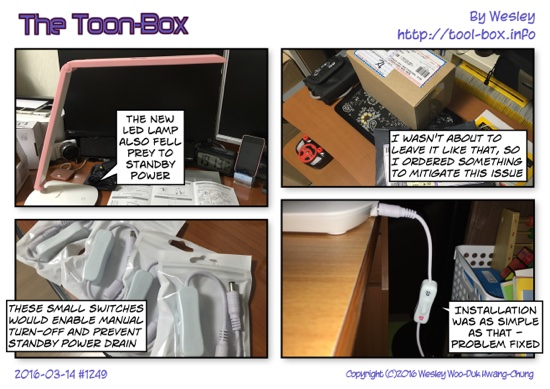
Today's "The Toon-Box"
Posted by Wesley on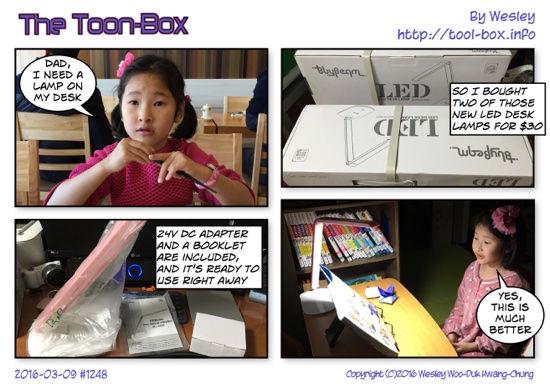
Now switching light bulbs to LED
Posted by Wesley on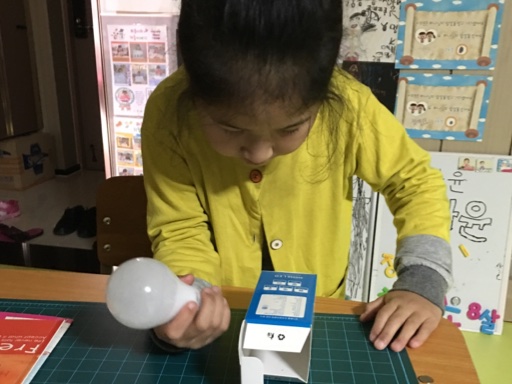
So we're getting LED bulbs, too?
After successfully deploying LED lamps across the FPL lamp fixtures, I thought that the lamps installed in the traditional screw-in sockets should be replaced as well. Ever since these lamps started to go mainstream about 5 years ago, the price kept dropping and the choices kept on growing. This meant that it was a good time to make the move.
Comparing the various offerings on the market, I ultimately settled on the BEAM series of lightbulbs from Sigma LED (formerly Sunsea). They were among the brightest for the rated power, yet priced competitively. Both the 8W and 10W versions cost me about US$3.75 (KRW 4,500) per bulb.
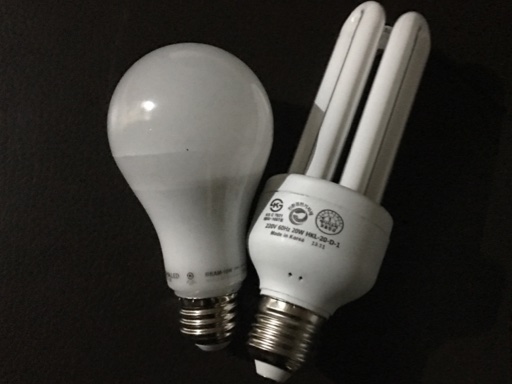
The new versus the not-so-old lightbulbs: Sigma LED and Hankuk CFL
They were set to replace the 20W compact fluorescent (CFL) bulbs made by Hankuk Lighting and installed throughout the house by default. Here is how they compare.
| Name | Type | Dim. (mm) | Power (W) | Lum.Flux (lm) |
|---|---|---|---|---|
| Hankuk HKL-20-D-1 | CFL E26 | 54⌀ x 161 | 20 | 1220 |
| Sigma BEAM-10W | LED E26 | 65⌀ x 122 | 10 | 1024 |
| Sigma BEAM-8W | LED E26 | 60⌀ x 108 | 8 | 744 |
The LED bulbs are shaped closer to the traditional incandescent bulbs, making them thicker and shorter than the CFL ones. Because of the larger diameter, some of the fixtures that were designed only with the CFL in mind may have trouble taking in the 10W ones. This is why I got 8W ones as a fallback.
Meanwhile, the spec comparison reveals a similar trend seen with the longer cousins. The LED bulbs meant to replace the CFL comes in at about half the power consumption and slightly lower total amount of light. I'll be checking if the reality reflects these numbers, of course.
Switching home lighting from FPL to LED
Posted by Wesley on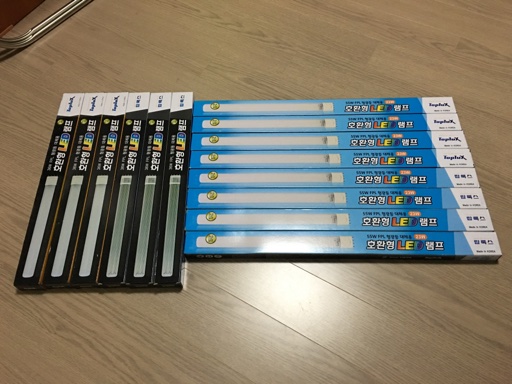
Fluorescent light replacement LED lamps from TopLux - 14 in all
Having a smart meter giving real-time power consumption data provided a lot of insights for my home. The baseline load when everything is idle is about 80W, and the refrigerator running at full power adds 90W to that. So when I noticed that more than 300W were being used during the evening hours even with the TV turned off, I had to track down what the culprit was.
It turned out that the sole reason for this uptick was the lighting. Fluorescent lights in the living room and the study room were turned on for several hours every day and contributing much to the total consumption. Knowing that LED lights were more efficient and that the price has come down a lot recently, I decided to make some major investment.
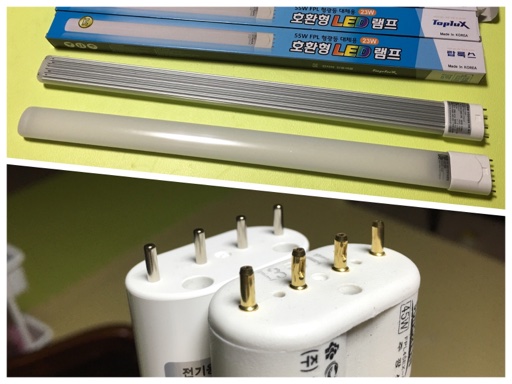
Front and back of the LED lamp / comparison of the connector (back: LED / front: FPL)
As with a lot of apartments in Korea, the typical type of lighting installed was PL compact fluorescent lights, or FPL for short. It uses 4-pin 2G11 socket and has external ballast. Lots of replacement methods exist - lamp-only, ballast + lamp (socket is kept), or total replacement. As the lamp-only method is simplest by far and not much more expensive than replacing everything, the choice was obvious for me. I ordered the relevant LED lamps manufactured and sold by TopLux of Korea which were on sale - 23W version cost about KRW 21,000 (US$17.50) and 15W one, KRW 14,000 (US$11.70). Here is how they stack up with the existing FPL lamps.
| Name | Type | Len. (mm) | Power (W) | Lum.Flux (lm) |
|---|---|---|---|---|
| Hyosun FPL45EX-D | FPL | 540 | 45 | 4060 |
| TopLux FT23-57 | LED | 535 | 23 | 3400 |
| Hyosun FPL32EX-D | FPL | 415 | 32 | 2600 |
| TopLux FT18W-04-57A | LED | 415 | 15 | 2250 |
According to the specifications, the LED lamp consumes about half the power while putting out about 85% of total light, or luminous flux, compared to the similarly sized FPL counterpart. This is indeed quite an increase in efficiency if it delivers. Visually, one side of the lamp is taken up by a long heat sink and uses the same four-pin layout. The pins themselves are simply round, not dimpled in the middle like the FPL it's replacing, so I suppose it won't "hook in" quite as well.
